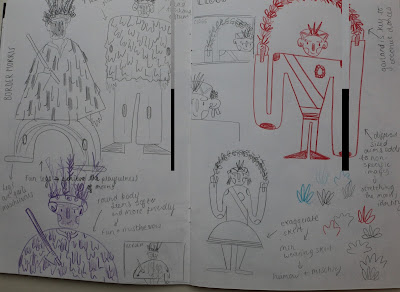EVALUATION
From the outset of this module, I was
unsure about my ability to use illustration to communicate experiences. Working
across the 3 stages of the module, I feel my approach to research has developed
from having an explicit goal, to being more about the awareness and experience
of unexpected things. Throughout the module I have been exploring how
experiences and narratives can be communicated through drawing and sound
mapping, and then studying how narratives in the sense of Folklore are upheld
in more practical traditions. I have
been encouraged by the idea of a parallel between context and function, taking
the approach that my illustrations could function as educational tools about
Folklore, but also promotional devices for the upkeep of these traditions.
Developing a strong awareness of my subject
matter encouraged me to consider new approaches to image making. I was strongly
influenced by the idea of texture and movement, with a subject matter that
demanded playful and vibrant responses, I experimented with collage and
handmade textures. Shape as an element I am familiar with in my practice seemed
a strong starting point, however, I decided to develop this through more
crafted techniques. Working with collage, I was interested to explore how my
work could operate on a micro scale to that of the Morris costumes. Making
collaged paper dolls, I was able to explore a fragility and craftsmanship I was
new to, but apply this to shape based work that seemed to communicate the mischievousness
and playfulness of the characters I had designed. Experimentation with textures
and collage is discernible in my sketchbook, alongside shape based character
development sketches.
For me, a success of the picture-book was
the consistent application of vibrant colours and crafted collages as these
seemed to maintain a playful aesthetic. The idea of telling an ‘untold story’
seemed to beg a response that was engaging and accessible to a wider audience.
This pushed me to explore abstract shapes within my characters, and a rejection
of human form, to create characters that were unfamiliar and therefore more
universal. This approach to image making seemed to drive the tone of voice of
my picture-book by achieving a sense of mischievousness and play across the
illustrations. This development was informed by the study of Marcus Oakley and
Rob Hodgson, both practitioners who focus on simplified shape in order to
communicate strong character dynamics.
On reflection, I feel that my body of
research was thorough and exhaustive, but perhaps ate into time I had to
develop my visual responses. In light of this I feel I could have benefitted
from having made more visual outcomes in the earlier stages of development, yet
I am pleased with the outcome of my work and feel it very much requites the
problems identified in my research.
The blogging process enabled me to draw more
informed conclusions about the direction of my work, and I feel
self-questioning was key to progress. Silent crits worked particularly well to
open my eyes to alternative approaches and make sense of the direction of my
narrative. I hadn’t quite captured the whole sense of the tradition, as my
peers pointed out, my illustrations were disjointed and needed a visual
conclusion. This drove me to consider all the characters together and in light
of this, my narrative became more sequential and cohesive. Furthering my
practice, a greater exploration of alternative directions could inform more
developed and relevant responses.

















































